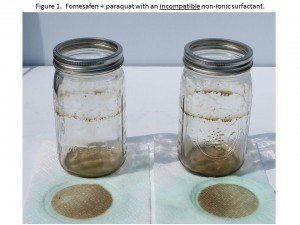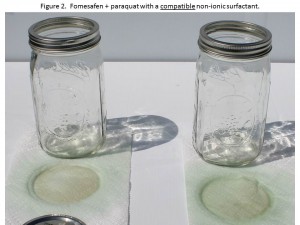During 2012, numerous tank compatibility issues occurred when mixing paraquat (Gramoxone SL 2.0 and others) with commonly used burndown or preemergence herbicides for cotton (Figure 1). Efforts over the winter have shown that each major supplier of adjuvants (non-ionic surfactants, AMS, crop oils, etc…) has products that are effective in avoiding compatibility issues (Figure 2). Two themes are clear from these tests: 1) use higher GPA’s such as 15 when possible, and 2) slow down and remember proper pesticide mixing procedures; such as adding half the water to the tank before adding ANY pesticide or adjuvant to the spray tank. Due to the numerous adjuvants available, differing water sources, and spray volumes, the best approach is for each grower to conduct compatibility tests prior to mixing herbicides in their spray tank.
Methods to conduct compatibility tests when applying paraquat mixtures at 15 GPA:
1. Place 1 quart of water in an approved clear container for pesticides.
2. Add adjuvants: 4.7 mls or 1 teaspoon equals 0.5% v/v as recommended. Invert 10 times and evaluate. Invert EACH time you add an adjuvant or pesticide to the container.
3. Add 7.9 mls of Reflex, or 1.5 teaspoons (this equals 1 pt/A).
4. Now each grower would have to decide which Reflex tank mix partner will be used such as Warrant, Direx, or Prowl. For Warrant add 24 mls or 5 teaspoons (equal to 3 pt/A), Direx add 12 ml or 2.5 teaspoons (equal to 1.5 pt/A) or Prowl add 16 mls or 3 teaspoons (equal to 1 qt/A).
5. Add 16 mls or 3 teaspoons of paraquat (this equals 1 qt/A).
6. After placing products in container, place lid on container and tighten. Invert at least 10 times and evaluate.
7. If incompatibility is apparent, repeat the test with the addition of a compatibility agent at the appropriate rate BEFORE adding a non-ionic surfactant. AMS-containing adjuvants have been effective in some cases.
8. After compatibility testing is complete, dispose of any pesticides and containers in accordance with the Storage and Disposal section of the labels for the herbicides used.
Spray Tank Mixing Order When Applying Paraquat:
1. Fill spray tank ½ full with clean water.
2. Begin tank agitation and continue agitation until the tank is empty after application.
3. High quality adjuvant(s).
4. Dry Formulations (WP, DF, etc.)
5. Liquid Formulations (SC, EC, L, etc.)
6. Paraquat
7. Fill remainder of spray tank
Additional Thoughts:
1. Using at least 15 GPA carrier volume will lesson compatibility issues; thus, the example above used 15 GPA, but if applying other volumes make appropriate changes above.
2. Each water source should be tested as it can greatly impact compatibility.
3. Test each adjuvant; test 2012 product and 2013 product even if it is the same name brand.
4. Warm water will lessen compatibility issues.
5. If compatibility problems do occur in the tank, a commercial degreaser (such as Purple Power) has been shown to be an effective cleaning agent. Avoid exposure to pesticides while cleaning tanks.
6. The example above uses general herbicide rates; adjust rates according to those being applied.
7. Pesticide mixing containers can be purchased: http://www.co2sprayers.com/results.cfm?Category=56&subcat=ALL
8. Syringes, marked in ml, can be purchased at: http://www.fishersci.com (just search syringes).
9. Joint efforts are underway between Syngenta and UGA to develop and distribute an inexpensive test kit that is simple to use for 2014.



